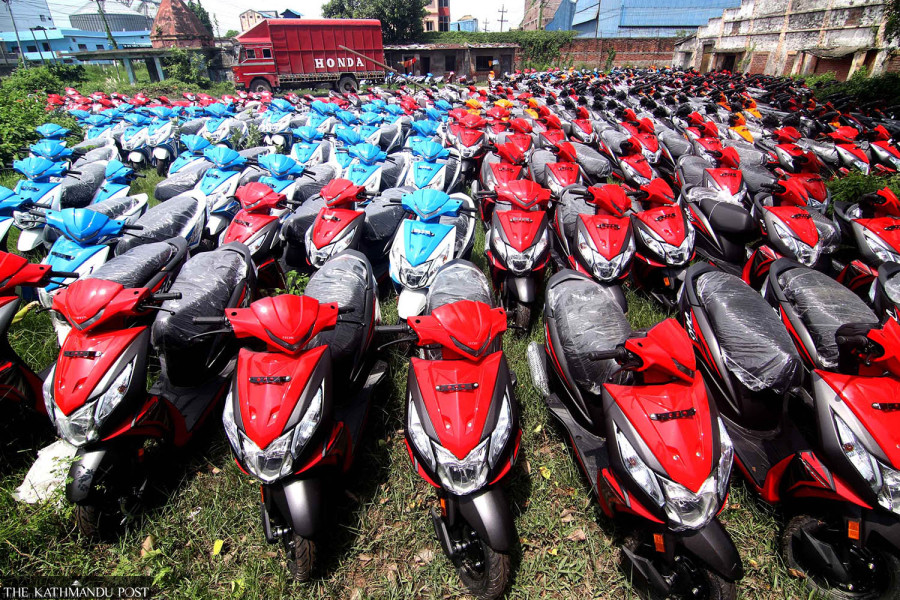Money
Nepal bans imports of luxury goods amid dwindling forex reserves
The government response follows growing concerns that the country could face an economic crisis.
Post Report
The government has formally banned imports of at least 10 goods, which it considers luxury or non-essential, in a bid to stop the country’s foreign exchange reserves from further depleting.
The ban has come into effect starting Tuesday and will last until mid-July 2022, the end of the current fiscal year. A notice to this effect had been published in the Nepal Gazette.
Earlier this month, Nepal’s central bank had issued verbal directives to the commercial banks to not issue letter of credit for the Nepali traders to import luxury goods.
Ballooning imports in recent months have led to massive amounts of foreign currency going out of the country, pushing the balance of payments into the red and raising concerns of a crisis, officials said.
The central bank’s response follows growing concerns that the country may be headed Sri Lanka's way as it faces a widening trade deficit, soaring balance of payment deficit, and decreasing remittance inflows and foreign exchange reserves.
According to the notice, the import of all kinds of readymade liquor [excluding raw materials], readymade cigarettes and tobacco products, and snacks like Lay’s potato chips and Kurkure, a crunchy snack, have been banned.
The government has also banned the import of diamond, excluding those used as industrial raw materials. The government has also banned the import of mobile sets that are worth more than $600 and colour televisions over 32 inches.
Imports of jeeps, cars and vans [except ambulances and hearses, vehicles that carry dead bodies] have also been banned. Likewise, the import of motorcycles above 250 cc, all kinds of toys and playing cards have also been banned.
On March 6, Nepal’s central bank slashed the daily import quota of gold to 10 kg to prevent the depletion of foreign exchange reserves.
According to Nepal Rastra Bank, during the eight months of 2021-22, imports increased 38.6 percent to Rs1.30 trillion compared to an increase of 2.1 percent a year ago.
Nepal’s current account remained at a deficit of Rs462.93 billion in the review period compared to a deficit of Rs151.42 billion in the same period of the previous year. The balance of payments remained at a deficit of Rs258.64 billion in the review period against a surplus of Rs68.01 billion in the same period of the previous year.
The country’s gross foreign exchange reserves decreased 16.3 percent to Rs1.17 trillion in mid-March 2022 from Rs1.39 trillion in mid-July 2021.
Anne-Marie Gulde-Wolf, acting director of the International Monetary Fund (IMF) Asia and Pacific Department, told a news conference on Tuesday that the Asian region faces a "stagflationary" outlook with economic growth being lower than previously expected and inflation being higher.
“That’s bound to happen in Nepal,” said Bishwambher Pyakuryal, an economist. "At the time of election, the money from political parties will distort the market. It will be difficult to address pressures on growth and tackle rising inflation.”
And what’s more worrying is the ongoing battle between the governor Maha Prasad Adhikari and Finance Minister Janardan Sharma at a time when the country’s economy is bleeding, said Pyakuryal.
Adhikari faced an automatic suspension on April 8 following the government decision, or finance minister decision, to set up a probe against Governor Adhikari.
The government had formed the probe panel accusing Adhikari of leaking sensitive information about its decisions and not fulfilling his responsibilities effectively. The Supreme Court, however, directed the government not to take any action against Adhikari, following which he has joined office.
The problem in the economy started as soon as Sharma was appointed the finance minister in the Sher Bahadur Deuba led coalition government and the battle between the two honchos started, according to some economists.
“Tuesday’s decision to ban imports ahead of the election may backfire,” said Pyakuryal. “The decision was appropriate but it came late. Now, it will not reduce imports because the finance ministry sources have said that traders have already been issued the letters of credit to import goods that are worth billions of rupees.”
Tuesday’s decision says that the government will allow imports of only those goods whose letter of credit has already been opened.
"Slower growth and rising prices, coupled with the challenges of war, infection and tightening financial conditions, will exacerbate the difficult policy trade-off between supporting recovery and containing inflation and debt,” according to the IMF.
Last December, Nepal Rastra Bank unveiled a new policy making it mandatory for importers to keep 100 percent margin amount to open the letter of credit to import 10 types of listed goods.
The central bank has decided to discourage the import of these goods considering that they are “non-essential”.
Also, traders need to keep 100 percent margin amount to open an letter of credit to import alcoholic drinks, tobacco, silver, furniture, sugar and foods that contain sweets, glucose, mineral water, energy drinks, cosmetics, shampoos, hair oils and colours, caps, footwear, umbrellas and construction materials such as bricks, marble, tiles and ceramics, among others.
According to a World Bank report titled "South Asia Economic Focus Reshaping Norms: A New Way Forward" released recently, higher commodity prices in Nepal are spurred by the war in Ukraine.
Transportation prices, construction costs and other consumer prices are rising which will dampen overall demand, the report said.
This may shave Nepal’s economic growth by an estimated 0.2 and 0.6 percentage points in the current fiscal year 2021-22 and the next fiscal year 2022-23 from previous projections, the multilateral funding agency said.
With the Russia-Ukraine war raging on, the World Bank has revised Nepal’s growth projection too.
Nepal’s economy, led by recovery of the services sector amid high Covid vaccination rates, is expected to grow by 3.7 percent in the current fiscal year and 4.1 percent in the next year.




 6.73°C Kathmandu
6.73°C Kathmandu














